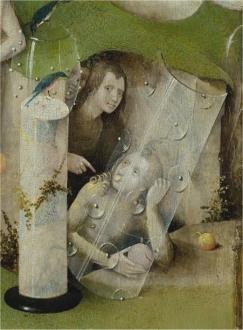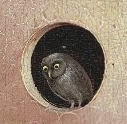








Fraenger (1890-1964) was an art historian and folklorist who in 1947 advanced the theory that Bosch was a member of a heretical sect and that understanding this could help us unravel the meaning of his paintings. This was one of the first of the modern "readings" of Bosch's paintings by recourse to external material, rather than by merely looking at the artwork itself. Fraenger has spawned a mass of interpretations of Bosch which require us to look at material outside the paintings, indeed often outside of art itself.
To make his case Fraenger begins by renaming The Garden of Earthly Delights to The Millenium Triptych, which enables him to recontextualise the work. He argues that Bosch was a member of a heretical sect called the Brethren of the Free Spirit and his painting depicted the activities of an Adamite cult within this movement. The doctrine of the Brethren of the Free Spirit reflected those of the 12th century mystic, Joachim of Fiore, who saw history as occurring in a series of epochs or millenia.
Fraeger adopts a esoteric view of Bosch:-
"... Bosch's metaphorical images are a system of hieroglyphs - half generally accepted representation, half a riddling game of hide-and-seek - that we can now recognise as a secret revelation."He first has to distance the Millenium Triptych from the Haywain which he sees merely as a social satire. He wants us to read the central panel of the Millenium Triptych as a positive affirmation of an Adamite cult, a second paradise. To Fraenger, the Adamite innocence leads to humanity being reborn as the New Adam in a new millenium, while those rejecting this are condemned to Hell.
"These [depicted in the Hell panel] are the unawakened, who, disregarding the Adamite gospel of primally pure, divine Nature, populate the depths of Hell either as members of the old Church, together with their monks and abbesses, or as worldlings, such as the minstrels, jugglers, gamblers and knights, who cannot escape Hell's punishments."Fraenger's thesis, while seeming coherent and meaningful on the general level, loses focus and collapses when he tries to explain individual details of the work. He is forced into inventions and stretching recorded history beyond its limits. He uses various tricks, such as naming certain elements of the painting with definitive and not descriptive names. This re-contextualises the imagery within Fraenger's thesis. It is an attempt to subtly seduce the reader to his viewpoint. Thus naming the fountain in the Garden of Eden as 'The Fountain of Life' is reasonably descriptive and acceptable, but when he labels an illustration of a dancing couple as 'The Uninitiated', another image from the central panel as 'The Gate of Initiation', the figures in the transparent globe form as 'The Alchemistic Marriage', another form as 'The Psychopomp', one as 'Ars Moriendi, the central form in the square lake as 'The Pythagorean Candle' and the tower to the left of this as 'The Ichthus', and the area on the lower right of the Central panel as 'The Cave of Pythagoras', he imposes his own meaning onto these images. There is nothing in the painting to give such names to these components, and it is entirely imposed onto Bosch's imagery. His invention spins out more ideosyncratic ideas as he sees the 'Cave of Pythagoras' as the abode of the Grand Master of the Free Spirit. Fraenger is then far, far away from conventional art history, in a realm entirely of his own invention, where his descriptive language becomes poetic.

"Together then with his bride the Grand Master on the morning of his wedding day must have entered the cave of Pythagoras, which has now become the transparent terrestrial womb of the eternal Mothers, on the threshold of which Eve redeemed lies dreaming. He points to the mother of the human race, as though to indicate that it is under her immortal aegis that he is taking to wife his own mortal bride, whom he thereby raises to the god-like status of 'beings of the kind of Pythagoras', that is, the status of mediators in whose honour all created beings dance and like the spheres move around the bridal crowns of the Grand Master and his bride, at the hour of noon."When he writes this Fraenger has then thrown away all the reputation as an art historian he gained in his earlier life, leaving behind scholarly description for poetic expression. Living in Berlin before and during World War II he had courageously stood up against the Nazi view of art history, risking his occupation and perhaps even his life, but to throw this considerable reputation away in such waffle and fantasy seems sad. A decade or so after his death his thesis became quite popular in the 1970s and 80s culture which was searching for new paradigms and willing to consider almost any new idea, but more recently scholars have turned away more and more from Fraenger, recognising that his perspective on Bosch was individualistic and entirely belief-driven. Many popular books on Bosch seem to unquestioningly accept Fraenger's ideas. Although Fraenger had the scholarly ability and depth of knowledge to be able to see the source material, other artists work, that Bosch drew on, which Fraenger documented in his big volume on Bosch, he stubbornly refused to contextualise Bosch amongst his contemporaries, and instead resorted to fantasy and contrivance.






